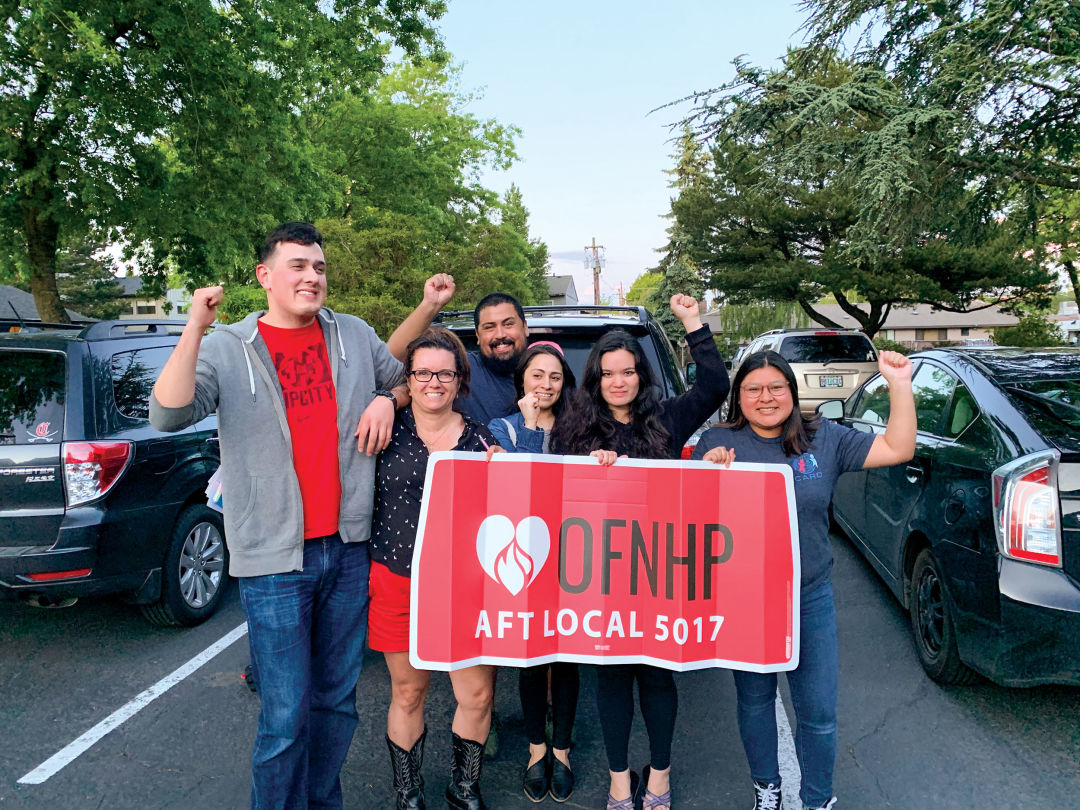What’s Behind the Youth-Driven Union Boom in the Pacific Northwest?

Rudich, second from right, and her coworkers celebrate after their successful unionization drive.
Mica Rudich was 22 when she got a job at the Portland branch of the Center for Autism and Related Disorders. Just a few months later, she found herself typing the words “labor union” into Google. “I had heard of it, this thing for workers,” she says, “but I had no idea what it was.”
The problems in her new place of work were myriad, she says: the pay was low, the schedule unpredictable, it was hard to secure health care, the turnover rate was high, and management didn’t seem to care. “It was universally known that it sucked.”
Rudich heard a neighbor was a labor organizer, and knocked on their door to introduce herself. She borrowed a book—Secrets of a Successful Organizer—and read it cover to cover. And then she and a coworker set about getting organized.
Unions, in case you missed it, are having a moment—recent polls show union approval at a near 50-year high in the US. And Portland has been at the vanguard of that upward swing. The city made headlines nationally in 2018 when the first official fast-food labor union in the country sprang from a local Burgerville outpost. Since then, stories of local unionizing have become a regular part of our news digest: from a Southeast pizza parlor to a Vancouver daily newspaper to a Portland advocacy nonprofit.
And much of the action is driven by a younger generation of educated, energetic organizers.
Nathan Howard, 28, was among a group of four young journalists who kicked off the unionization of the Columbian newspaper. “It didn’t start as a union conversation,” he recalls. “It started as a grievance conversation.” He says employees felt complaints about workplace bullying, inappropriate comments, and wages were not being adequately addressed. “For me ... most of the issues stem from a mentality of ‘We’re going to hire young reporters, burn them out after a couple of years, and then show them the door.’”
Once the word was out, the company—a family-owned business that emerged from bankruptcy in 2010 and has maintained a profit since, despite declines in advertising revenue—tried to dissuade its employees from voting in favor of a union. One of its anti-union meetings happened to take place while some newsroom staff were out covering an active-shooter situation at Vancouver’s Smith Tower, a 15-story public housing complex for seniors. “We had reporters out there putting their lives on the line, and simultaneously the company is back in the other building saying, ‘We don’t think you guys deserve a living wage,’” Howard says. “I think that was a hard pill for people to swallow.”
Howard and Rudich both fit squarely into the demographic that currently boasts the highest approval rating for unions nationwide—18 to 34-year-olds. And both of them found success: the Portland branch of the Center for Autism voted to unionize in May of this year; the Columbian, in October. (Representatives for the employers didn’t respond to repeated requests for comment.)
Since her place of work unionized, however, Rudich has found a new gig. “I’m a union organizer now!”
She works with CIR, the Committee of Interns and Residents, as a national union organizer, traveling around the country to help people do what she did in Portland. “As young people, we have a long way to go until retirement,” she says. “And it’s so easy for us, especially in this market, to think, ‘I should be grateful to be getting paid anything!’ But you’re literally dedicating your life to make someone else money. I think the least you deserve is a voice in how they treat you.”


